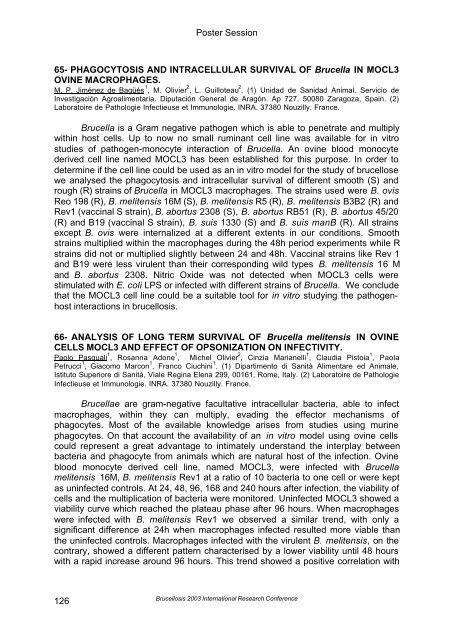Brucellosis 2003 proceedings - PHIDIAS
Brucellosis 2003 proceedings - PHIDIAS
Brucellosis 2003 proceedings - PHIDIAS
Create successful ePaper yourself
Turn your PDF publications into a flip-book with our unique Google optimized e-Paper software.
Poster Session<br />
65- PHAGOCYTOSIS AND INTRACELLULAR SURVIVAL OF Brucella IN MOCL3<br />
OVINE MACROPHAGES.<br />
M. P. Jiménez de Bagüés 1 , M. Olivier 2 , L. Guilloteau 2 . (1) Unidad de Sanidad Animal. Servicio de<br />
Investigación Agroalimentaria. Diputación General de Aragón. Ap 727. 50080 Zaragoza, Spain. (2)<br />
Laboratoire de Pathologie Infectieuse et Immunologie. INRA. 37380 Nouzilly. France.<br />
Brucella is a Gram negative pathogen which is able to penetrate and multiply<br />
within host cells. Up to now no small ruminant cell line was available for in vitro<br />
studies of pathogen-monocyte interaction of Brucella. An ovine blood monocyte<br />
derived cell line named MOCL3 has been established for this purpose. In order to<br />
determine if the cell line could be used as an in vitro model for the study of brucellose<br />
we analysed the phagocytosis and intracellular survival of different smooth (S) and<br />
rough (R) strains of Brucella in MOCL3 macrophages. The strains used were B. ovis<br />
Reo 198 (R), B. melitensis 16M (S), B. melitensis R5 (R), B. melitensis B3B2 (R) and<br />
Rev1 (vaccinal S strain), B. abortus 2308 (S), B. abortus RB51 (R), B. abortus 45/20<br />
(R) and B19 (vaccinal S strain), B. suis 1330 (S) and B. suis manB (R). All strains<br />
except B. ovis were internalized at a different extents in our conditions. Smooth<br />
strains multiplied within the macrophages during the 48h period experiments while R<br />
strains did not or multiplied slightly between 24 and 48h. Vaccinal strains like Rev 1<br />
and B19 were less virulent than their corresponding wild types B. melitensis 16 M<br />
and B. abortus 2308. Nitric Oxide was not detected when MOCL3 cells were<br />
stimulated with E. coli LPS or infected with different strains of Brucella. We conclude<br />
that the MOCL3 cell line could be a suitable tool for in vitro studying the pathogenhost<br />
interactions in brucellosis.<br />
66- ANALYSIS OF LONG TERM SURVIVAL OF Brucella melitensis IN OVINE<br />
CELLS MOCL3 AND EFFECT OF OPSONIZATION ON INFECTIVITY.<br />
Paolo Pasquali 1 , Rosanna Adone 1 , Michel Olivier 2 , Cinzia Marianelli 1 , Claudia Pistoia 1 , Paola<br />
Petrucci 1 , Giacomo Marcon 1 , Franco Ciuchini 1 . (1) Dipartimento di Sanità Alimentare ed Animale,<br />
Istituto Superiore di Sanità, Viale Regina Elena 299, 00161, Rome, Italy. (2) Laboratoire de Pathologie<br />
Infectieuse et Immunologie. INRA. 37380 Nouzilly. France.<br />
Brucellae are gram-negative facultative intracellular bacteria, able to infect<br />
macrophages, within they can multiply, evading the effector mechanisms of<br />
phagocytes. Most of the available knowledge arises from studies using murine<br />
phagocytes. On that account the availability of an in vitro model using ovine cells<br />
could represent a great advantage to intimately understand the interplay between<br />
bacteria and phagocyte from animals which are natural host of the infection. Ovine<br />
blood monocyte derived cell line, named MOCL3, were infected with Brucella<br />
melitensis 16M, B. melitensis Rev1 at a ratio of 10 bacteria to one cell or were kept<br />
as uninfected controls. At 24, 48, 96, 168 and 240 hours after infection, the viability of<br />
cells and the multiplication of bacteria were monitored. Uninfected MOCL3 showed a<br />
viability curve which reached the plateau phase after 96 hours. When macrophages<br />
were infected with B. melitensis Rev1 we observed a similar trend, with only a<br />
significant difference at 24h when macrophages infected resulted more viable than<br />
the uninfected controls. Macrophages infected with the virulent B. melitensis, on the<br />
contrary, showed a different pattern characterised by a lower viability until 48 hours<br />
with a rapid increase around 96 hours. This trend showed a positive correlation with<br />
126<br />
<strong>Brucellosis</strong> <strong>2003</strong> International Research Conference
















